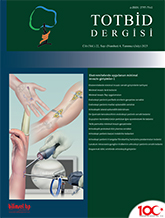
Proximal row carpectomy is indicated in conditions such as scapholunate advanced collapse (SLAC), scaphoid nonunion advanced collapse (SNAC), Kienböck`s disease, chronic carpal instability. Prerequisite for this operation is normal cartilage in the head of the capitatum and preserved lunate fossa; therefore, SLAC stage III-IV and SNAC stage III are contraindications. Ulnar translocation due to extensive carpal instability in pre-existing rheumatoid patients or radioscacocapitate (RSC) ligament injury in patients with radial styloidectomy greater than 4 mm are relative contraindications. When performing arthroscopic proximal row carpectomy (APRC), midcarpal portals and 3-4 radiocarpal portals are preferred, respectively. Scapholunate and volar central midcarpal portals can be used as adjuncts. It has been shown that the patients` mean wrist flexion/extension arcs are preserved upto 78%, and the radial and ulnar deviation arcs are preserved upto 70%. It was seen that the grip strength was 83% on the contralateral site and the patient satisfaction was high (94%). Arthroscopic proximal row carpectomy (APRC) reduces trauma to the dorsal capsular ligaments. This allows for early recovery of motion and strength compared to the open process. However, when comparing long-term outcomes, arthroscopic procedure may not have significant clinical benefit over open procedure. This is a technically demanding procedure and should only be performed by experienced surgeon, accidental injury to articular cartilage surfaces can easily occur. There is a considerable learning curve; it can be done in less than 1 hour as you gain experience.